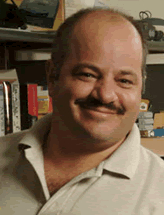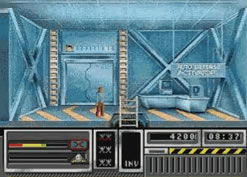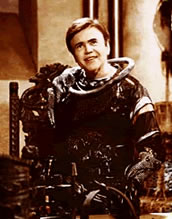We recently delved into the history of Digital Pictures, the premier developer of full-motion video games. Over a little more than half a decade, the company set the industry on its ear and ushered in a new genre of video games that still stirs controversy to this day. Love them or hate them, one simply cannot deny the impact that FMV had on gaming and that there is a definite legacy there that must be recognized.
 Sega-16 was lucky enough to chat with a man who was at the forefront of this history-making enterprise. As a programmer from the days of the Atari 2600 and Intellivision, Steve DeFrisco has created games for Imagic and later worked in Sony’s R&D division. He even spent some time at Nolan Bushnell’s Axlon (where Tom Zito got his start in gaming). When he arrived at Digital Pictures. DeFrisco worked on such titles as Prize Fighter, Citizen X, and Slam City with Scotty Pippen. He played a major part in making some of the Sega CD’s most known titles come to life. He was also around as the industry made the transition from 2D to 3D, and he saw the effect this had on Tom Zito’s company. He now works for Volition Inc. (makers of the Descent, Red Faction, and Saints Row series).
Sega-16 was lucky enough to chat with a man who was at the forefront of this history-making enterprise. As a programmer from the days of the Atari 2600 and Intellivision, Steve DeFrisco has created games for Imagic and later worked in Sony’s R&D division. He even spent some time at Nolan Bushnell’s Axlon (where Tom Zito got his start in gaming). When he arrived at Digital Pictures. DeFrisco worked on such titles as Prize Fighter, Citizen X, and Slam City with Scotty Pippen. He played a major part in making some of the Sega CD’s most known titles come to life. He was also around as the industry made the transition from 2D to 3D, and he saw the effect this had on Tom Zito’s company. He now works for Volition Inc. (makers of the Descent, Red Faction, and Saints Row series).
Sega-16: How and when did you get your start at Digital Pictures?
Steve DeFrisco: When I interviewed for a job at Axlon, I interviewed with Nolan Bushnell and Tom Zito. Tom was interviewing for people to work on the original project that Night Trap and Sewer Shark were created for. Years later, Mark Klein (I worked with Mark at Imagic) contacted me and asked if I wanted to join Digital Pictures.
Sega-16: People have said that working there was very different that at other companies? Do you agree?
Steve DeFrisco: I started there during the first wave of video game programmers. We could wear cut-offs, t-shirts and sandals to work! We worked all night, ate out all the time, went on trips together. I have not worked in such a relaxed atmosphere since.
Sega-16: Working with full-motion video was quite a different world from programming Atari 2600 games. What did you think of FMV initially?
Steve DeFrisco: I thought it was a really cool idea – the quality of graphics in games at the time was still pretty much cartoon-style, with a few companies moving towards a more realistic style. Talk about realistic, we *were* real.
Sega-16: Did you ever think games of this type would catch on, or were you surprised by their success?
Steve DeFrisco: They were fun to play, if you “got it” and accepted the limitations. They were certainly not the “twitch” variety of games.
 Sega-16: Citizen X was the first game you worked on for Digital Pictures, but it wasn’t released until 2002 (by Good Deal Games). Why do you think it took so long?
Sega-16: Citizen X was the first game you worked on for Digital Pictures, but it wasn’t released until 2002 (by Good Deal Games). Why do you think it took so long?
Steve DeFrisco: It was released? I’ve got to get a copy! The reason it was delayed was because DP and Sega thought it couldn’t compete with the pure fighting games that were coming out at that time – Mortal Kombat, etc.
Sega-16: I thought you knew that Good Deal Games had released it! Now that you know, how does it make you feel to finally see the game available for sale?
Steve DeFrisco: I really didn’t know it was available until I read your question. That’s cool! I have to get a copy!
Sega-16: Prize Fighter is quite a solid boxing title that makes better use of FMV than a lot of other games out there. How hard was it to produce a realistic boxing engine using only video? The presentation would logically be spot-on, but the gameplay would seem to be a major challenge to produce accurately.
Steve DeFrisco: We worked with Ron Stein, who was the boxing coordinator for the Rocky movies. We went to L.A. twice to confer with him in the planning stages. We designed the gameflow, and let Ron and his stunt guys define the choreography. I’m no boxer, I couldn’t even guess what movements would work. I believe it was Ron’s idea for the “clenches” at the end of each section of gameplay so we could transition from one section to the next seamlessly. So, they designed the choreography for each section – the player’s movements, the opponent’s movements, when each person was to throw punches and leave openings. It certainly would not have been a good game without their input and expertise.
Sega-16: You once mentioned that there were some major bugs that affected the gameplay and had to be ironed out. What happened exactly?
Steve DeFrisco: The acceptance by SEGA was delayed by at least a month. There was a timing issue that during a certain sequence, the frame count was off, and if you hit a certain punch, the system would get confused and the round would never finish. It would hang forever at 0:01 second left in the round. Because the sequences were chosen randomly, it was rare, which made it very hard to track down.
Sega-16: What exactly happened with Maximum Surge? Why wasn’t it released? Tom Zito seemed really excited about it when he spoke to Next Generation magazine in 1995.
Steve DeFrisco: DP sort of ran out of money, the Saturn was being overtaken by other game machines… I know we basically finished it, but the FMV “era” was sort of over, and… who knows?
Sega-16: The game really seemed to offer something new in the FMV genre. Do you think it would have caught on had it been released?
 Steve DeFrisco: Maximum Surge had some cool elements in it. I designed a cool hallway ducking-in-and-out-of-cover that looked great and was pretty fun to play. It was probably the most ambitious in terms of a “twitch” game that we created.
Steve DeFrisco: Maximum Surge had some cool elements in it. I designed a cool hallway ducking-in-and-out-of-cover that looked great and was pretty fun to play. It was probably the most ambitious in terms of a “twitch” game that we created.
Sega-16: Do you know why Digital Pictures closed down? Was it due to gaming’s move toward 3D or did Zito just decide to move on?
Steve DeFrisco: Tom Zito was passionate about the FMV genre, and certainly wanted to see it be pushed forward, with eventual on-line delivery of content. But the market had had enough of it, 3D was really catching people’s imagination, and the money dried up. Remember, these games cost as much as a big budget film to produce. I don’t know all of the financials, but it was a big factor.
Sega-16 would like to thank Mr. DeFrisco for taking the time for this interview.

Recent Comments